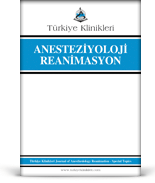Objective: Procalcitonin, white blood cell count, neutrophil count, C-reactive protein and mean plate volume are biomarkers that are frequently used in clinics and whose levels increase in infective and inflammatory processes. We aimed to investigate the relationship between procalcitonin and other biomarkers based on normal and abnormal procalcitonin values in critically ill patients admitted to the intensive care units. Material and Methods: A total of 9.867 records of 1.357 patients admitted to different intensive care units were included in the study. Firstly, the correlation between procalcitonin values and other biomarkers was evaluated. Then, a cut-off value for , white blood cell count, neutrophil count, C-reactive protein and mean platelet volume was determined based on normal and abnormal procalcitonin values using ROC analysis. Results: The correlation between procalcitonin and the other inflammatory markers was statistically significant (p˂0.001) for the relationship between all biomarker values and procalcitonin level. A weak positive correlation was found only between the procalcitonin and C-reactive protein level (r=0.272). There was either no correlation between other biomarker values and the procalcitonin level. The results of ROC analysis showed that sensitivity was very low (1-1.3%), although AUC > 0.5, p<0.001, specificity 99.9% and LR + values were high in all tests. Conclusion: Abnormal and normal procalcitonin levels were primarily correlated with C-reactive protein levels in critically ill patients admitted to intensive care units and that identifying a suitable cutoff value for white blood cell count, C-reactive protein, neutrophil count, and mean platelet volume based on abnormal and normal procalcitonin levels would not be useful due to low sensitivity values.
Keywords: Biomarkers; critically ill patients; procalcitonin
Amaç: Prokalsitonin, beyaz kan hücre sayımı, nötrofil sayımı, Creaktif protein ve ortalama trombosit volümü enfeksiyon ve inflamasyonda düzeyleri artan hastalarda klinikte sıklıkla kullanılan biyobelirteçlerdir. Amacımız yoğun bakım üniesinde yatan kritik hastalığıolan normal ve anormal prokalsitonin değerleri temel alınarak diğer biyobelirteçlerle arasındaki ilişkiyi incelemektir. Gereç ve Yöntemler: Bu çalışmaya farklı yoğun bakım ünitelerinde yatan 1.337 hastanın toplam 9.867 verisi dahil edildi. İlk önce prokalsitonin değerleriyle diğer inflamatuar biyobelirteçler arasındaki korelasyon değerlendirildi. Sonrasında beyaz kan hücresi, nötrofil sayımı, C-reaktif protein ve ortalama trombosit volümü cut-off değerleri alıcı işletim karakteristik eğrisi analizi kullanılarak normal ve anormal prokalsitonin temelinde belirlendi. Bulgular: Prokalsitonin ve diğer inflamatuar biyobelirteçler arasındaki korelasyon tüm biyobelirteç değerleriyle prokalsitonin düzeyi arasındaki ilişki açısından istatistiksel olarak anlamlıydı (p<0,001). Sadece prokalsitonin ve C-reaktif protein düzeyi arasında zayıf pozitif korelasyon bulundu (r=0,272). Diğer biyobelirteç değerleriyle prokalsitonin düzeyleri arasında hiçbir korelasyon yoktu. Alıcı işletim karakteristik eğrisi analizi gösterdi ki duyarlılık çok düşük (%1-1,3), fakat eğri altında kalan alan >0,5, p<0,001, özgünlük %99,9 ve olabilirlik oranı + değerleri tüm testlerde yüksekti. Sonuç: Anormal ve normal prokalsitonin düzeyleri yoğun bakım ünitesinde yatan kritik hastalıklı hastalarda koreleydi, anormal ve normal prokalsitonin değerleri temelinde beyaz kan hücre sayısı, C-reaktif protein, nötrofil sayısı ve ortalama trombosit volümü için uygun bir kesme değeri belirlendi ancak çok düşük duyarlılık nedeniyle bunların kullanışsız olduğu belirlendi.
Anahtar Kelimeler: Biyobelirteç; kritik hastalar; prokalsitonin
- Abdul-Aziz MH, Alffenaar JC, Bassetti M, Bracht H, Dimopoulos G, Marriott D, et al. Antimicrobial therapeutic drug monitoring in critically ill adult patients: a position paper. Intensive Care Med. 2020;46(6):1127-53.[Crossref] [PubMed] [PMC]
- Levy MM, Evans LE, Rhodes A. The surviving sepsis campaign bundle: 2018 update. Intensive Care Med. 2018;44(6):925-8.[Crossref] [PubMed]
- Tan M, Lu Y, Jiang H, Zhang L. The diagnostic accuracy of procalcitonin and C-reactive protein for sepsis: a systematic review and meta-analysis. J Cell Biochem. 2019;120(4):5852-9.[Crossref] [PubMed]
- Opal SM, Wittebole X. Biomarkers of infection and sepsis. Crit Care Clin. 2020;36(1):11-22.[Crossref] [PubMed]
- Riedel S. Predicting bacterial versus viral infection, or none of the above: current and future prospects of biomarkers. Clin Lab Med. 2019;39(3):453-72.[Crossref] [PubMed]
- Bassetti M, Russo A, Righi E, Dolso E, Merelli M, D'Aurizio F, et al. Role of procalcitonin in bacteremic patients and its potential use in predicting infection etiology. Expert Rev Anti Infect Ther. 2019;17(2):99-105.[Crossref] [PubMed]
- Creamer AW, Kent AE, Albur M. Procalcitonin in respiratory disease: use as a biomarker for diagnosis and guiding antibiotic therapy. Breathe (Sheff). 2019;15(4):296-304.[Crossref] [PubMed] [PMC]
- Raveendran AV, Kumar A, Gangadharan S. Biomarkers and newer laboratory investigations in the diagnosis of sepsis. J R Coll Physicians Edinb. 2019;49(3):207-16.[Crossref] [PubMed]
- Nargis W, Ibrahim M, Ahamed BU. Procalcitonin versus C-reactive protein: usefulness as biomarker of sepsis in ICU patient. Int J Crit Illn Inj Sci. 2014;4(3):195-9.[Crossref] [PubMed] [PMC]
- Korniluk A, Koper-Lenkiewicz OM, Kamińska J, Kemona H, Dymicka-Piekarska V. Mean platelet volume (MPV): new perspectives for an old marker in the course and prognosis of inflammatory conditions. Mediators Inflamm. 2019;2019:9213074.[Crossref] [PubMed] [PMC]
- Rowland T, Hilliard H, Barlow G. Procalcitonin: potential role in diagnosis and management of sepsis. Adv Clin Chem. 2015;68:71-86.[Crossref] [PubMed]
- Gregoriano C, Heilmann E, Molitor A, Schuetz P. Role of procalcitonin use in the management of sepsis. J Thorac Dis. 2020;12(Suppl 1):S5-15.[Crossref] [PubMed] [PMC]
- Aloisio E, Dolci A, Panteghini M. Procalcitonin: between evidence and critical issues. Clin Chim Acta. 2019;496:7-12.[Crossref] [PubMed]
- Hamade B, Huang DT. Procalcitonin: where are we now? Crit Care Clin. 2020;36(1):23-40.[Crossref] [PubMed] [PMC]
- Brindle RJ, Ijaz A, Davies P. Procalcitonin and cellulitis: correlation of procalcitonin blood levels with measurements of severity and outcome in patients with limb cellulitis. Biomarkers. 2019;24(2):127-30.[Crossref] [PubMed]
- Çolak A, Yılmaz C, Toprak B, Aktoğu S. Procalcitonin and CRP as biomarkers in discrimination of community-acquired pneumonia and exacerbation of COPD. J Med Biochem. 2017;36(2):122-6.[Crossref] [PubMed] [PMC]
- Ocakli B, Tuncay E, Gungor S, Sertbas M, Adiguzel N, Irmak I, et al. Inflammatory markers in patients using domiciliary non-invasive mechanical ventilation: C reactive protein, procalcitonin, neutrophil lymphocyte ratio. Front Public Health. 2018;6:245.[Crossref] [PubMed] [PMC]
- Karaman S, Coskun A. Do MCHC, MPV, and procalcitonin levels determine prognosis in acute coronary syndrome? Emerg Med Int. 2019;2019:6721279.[Crossref] [PubMed] [PMC]
- Aydemir C, Aydemir H, Kokturk F, Kulah C, Mungan AG. The cut-off levels of procalcitonin and C-reactive protein and the kinetics of mean platelet volume in preterm neonates with sepsis. BMC Pediatr. 2018;18(1):253.[Crossref] [PubMed] [PMC]







.: İşlem Listesi